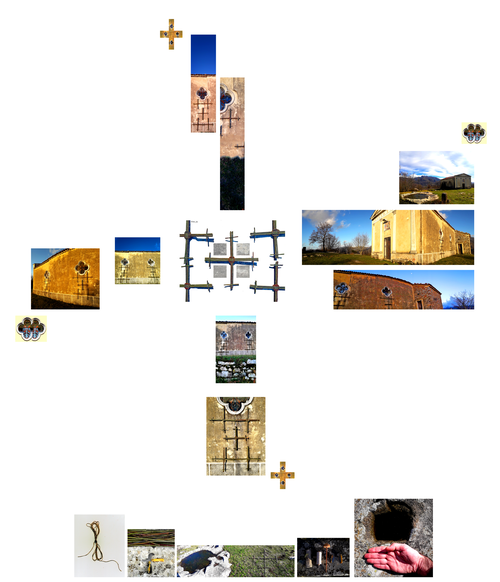Giuseppe Mongiello

Pop Up #2: The Rose of the Crosses - a social and time specific installation: crosses: 80cm x 80cm, tap-root of chestnut, hand twisted linen, stalks of a broom - Location: S.S. Annunziata Sanctuary, Civitella Mount, Moio, Italy
The "Pop Up" characterizes a limit, a mark and identifies a territory or an intersection. In the form of minimum architectures, ephemeral or immovable structures. "The Rose of the Crosses", is an work produced to interact with the devotion of the Pellare community, that on the 25th of March, every year, go on pilgrimage at the Sanctuary of the Annunziata, on the Civitella top of Moio. During the ascent trail, they intertwined a crosses with chestnut trees. The officiant blesses them at the end of the liturgy. The so-called "rite of the crosses" evokes the propitiatory qualities of the object, in which the oral narration suggests, is placed as protection in the vineyards, houses and fields. The cross, cardinal system and placement of the elements, in the course of history has changed according to the reference cultural needs. In its simplicity encloses the heavenly order, orientation in space and time. I see it as symbol of the holiness of human gathering. — Giuseppe Mongiello
Pop Up # 2: The Rose of the Crosses - Soziale Plastik in zeitlich begrenzter Exposition: Kreuze: 80cm x 80cm, Kastanienwurzel, handgedrehtes Leinen, Besenstiele - Ort: S. S. Annunziata Sanctuary, Civitella Mount, Moio, Italien
Das "Pop Up" charakterisiert, begrenzt, markiert und identifiziert ein Gebiet wie zum Beispiel eine Straßenkreuzung. Das "Pop Up" bedient sich minimaler architektonischer Strukturen und wird nur temporär installiert. "The Rose of the Crosses" ist ein Werk, das geschaffen wurde, um mit den Gläubigen der Pellare-Gemeinde zu interagieren, die jedes Jahr am 25. März zum Heiligtum der Annunziata, zur Civitella-Spitze von Moio pilgern. Während des Aufstiegs verflechten sie Kreuze mit Kastanienbäumen. Ein Offizieller segnet sie am Ende der Liturgie. Der sogenannte "Kreuz Ritus" ruft die heiligen Eigenschaften des Kreuzes hervor, damit wie die mündliche Erzählung nahe legt, es als Schutz in den Weinbergen, Häusern und Feldern fungiert. Das Kreuz als Symbol hat sich im Laufe der Geschichte entsprechend den kultureller Bedürfnissen geändert. In seiner Einfachheit stellt es sowohl die göttliche Ordnung, als auch zeitliche und räumliche Orientierung dar. Ich sehe es als Symbol der Heiligkeit der zwischenmenschlichen Begegnung. — Giuseppe Mongiello
